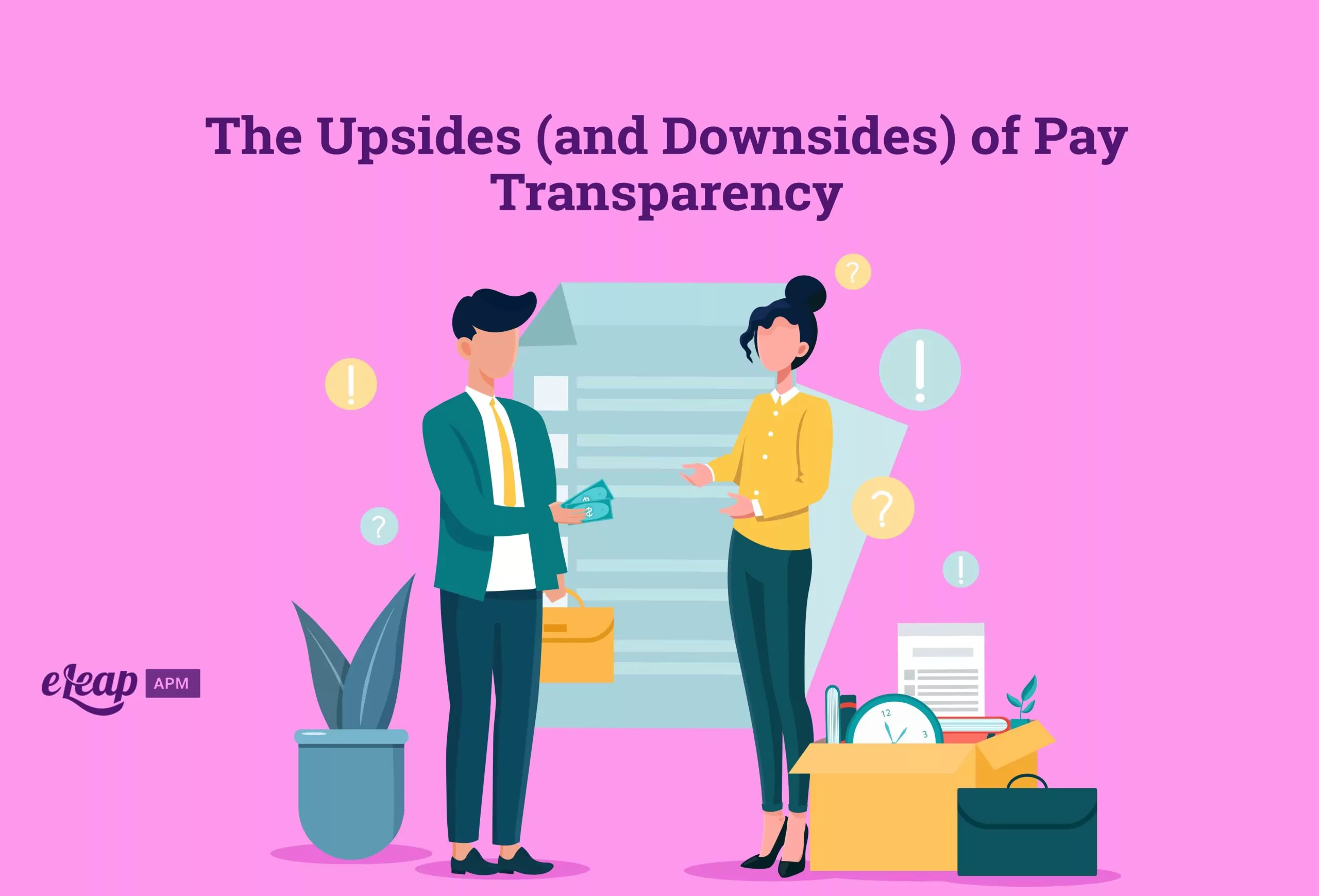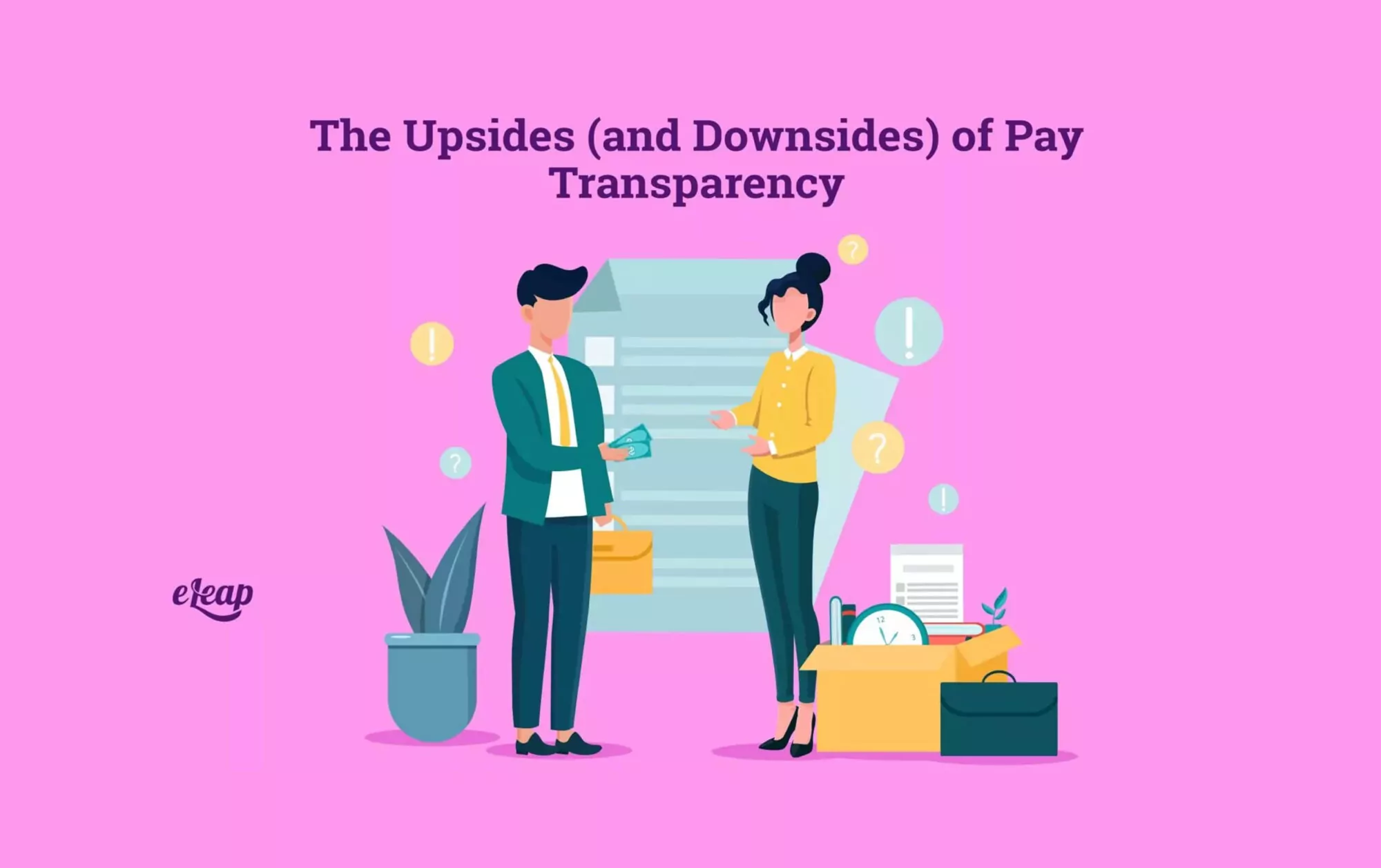The Upsides (and Downsides) of Pay Transparency

Pay transparency has long been considered taboo in the workplace, but that may change. In fact, in a Glassdoor survey, 70% of employees (from seven different countries and several industries) agree that salary transparency is good.
Glassdoor is an excellent example of what a robust tool salary transparency can be. Their platform, which helps job seekers find compatible roles and allows employees to rate their workplace culture anonymously, also features a tool to report your current role and salary anonymously.
Identifying the principal driver toward salary transparency is a larger mission—employees want to close pay gaps between marginalized groups such as women, people of color, and other demographics who are chronically underemployed and underpaid. The first way to educate people on their value is to allow them to honestly assess whether others of the same relative education and experience are in the same general pay range as they are.
However, this doesn’t mean salary transparency has no downsides. It can cause a huge divide between employees. Employees may resign in droves or demand an immediate raise if they find out their peers are making more than them. This is cause for concern for employers. Plus, sometimes more goes into someone’s salary than their demographics and experience level. – For example, an employee hired during high inflation may have a higher hourly pay, which reflects that.
Overall, society seems to be heading toward a more salary-transparent future. What benefits and detriments could businesses experience as a result?

Recent Progress in Pay Transparency
Salary transparency is very relevant right now. In Q2 of 2022, New York and Colorado instated a legislature forcing all companies to publish their salary range alongside every job posting. 22 of the 50 states have laws against asking candidates for their previous salary in the interviewing process.
This is because if an employer knows how much the candidate was willing to accept at a previous job, they may offer the candidate more than they were making but slightly less than what is usual for the role, with the knowledge that the candidate may see it as a win. If employers have no idea of a candidate’s previous salary, they must assess the salary offer based on the candidate and the market rate for the role. This creates a fairer process for the employee.
You can’t talk about what you do with your colleagues, right? Wrong. The National Labor Relations Act protects employees’ right to talk about their salary at work. However, it doesn’t stop companies from trying to scare employees from disclosing their salaries to their colleagues.
Some companies argue that discussing salary at work is unprofessional and, therefore, discouraged. Others may take a less ethical approach and tell employees that conversations about what they make at work are off-limits, and they hope employees aren’t aware of their rights under NLRA.
Companies do not like employees sharing salaries for many reasons, but the main reason is that many employers know there are salary disparities in their companies. When revealed, this can cause rifts among colleagues, tense conversations about pay bumps, and even resignations.
The Benefits of Pay Transparency
Many companies have committed to a pay-transparent culture, which may positively impact their employees’ happiness and boost recruiting efforts. Buffer, a social media start-up, has a progressive culture, including 4-day workweeks and a 100% pay transparency policy. Buffer even publicly posts its employees’ salaries for all to see. There are numerous benefits to models like Buffer’s that promote salary transparency.
Builds Trust Among Employees
Why would seeing your salary compared to your colleagues’ salary make you any happier? Assuming there are no significant or inappropriate pay gaps, it helps employees build trust in their organizations. Without transparency, most employees assume the worst is happening behind the scenes.
They may distrust that they are getting paid their total value. In a company that doesn’t support a pay transparency culture, employees essentially have two options: talk about what they make with their colleagues (and in many cases, risk being called out for “inappropriate” behavior) or wonder endlessly.
Pay gaps are still accurate – according to the Institute for Women’s Policy Research, in 2021, women working full-time jobs earned 88.3% of men working full-time jobs. Pay gaps were even more expansive when it came to female minorities. In a comparison of median weekly earnings of white men working full-time, a Hispanic woman’s full-time earnings were just 58.4 percent, and a black woman’s 63.1 percent, as compared to the males’ salaries.
In a world where this information is readily available to us, without salary transparency from organizations, most women and minorities will assume they are underpaid, even if they are not.
Publishing this information, or at least being open about it internally, is a smart move for companies to keep their employee’s trust, therefore keeping them more engaged.
Provides an Opportunity to Close Pay Gaps
For companies that have significant objections to becoming more salary transparent, there is usually a major driving force behind that hesitation: they know, to some extent, that there are pay gaps within the organization.
This can have significant consequences for employers. For example, look at Carrie Gracie’s case. Gracie was a highly successful member of the BBC team. She was the Chinese editor for BBC and one of the most senior journalists on the team.
During her initial onboarding, Gracie was told she would make around the same salary as the male North American editor at BBC. He made around 243,000 dollars per year at BBC. After accepting the job, Gracie was surprised to see her salary was closer to 164,000 dollars per year, a nearly hundred-thousand-dollar difference from her expected estimate.
Gracie was no entry-level novice either—she had been at the BBC in numerous roles for 30 years. Still, she was underpaid. To add insult to injury, she only discovered she was being underpaid when, in 2017, the British government mandated BBC (which it funds) to disclose the salaries of its top talent.
Had the government not stepped in and forced BBC to disclose its employees’ salaries, it’s fair to say Gracie might still be employed there and grossly underpaid to this day.
Implementing a plan to disclose salaries and become a transparency-friendly organization allows employers to take control of the narrative. The BBC scenario wouldn’t have happened if the company had released its own internal report on employees’ salaries and welcomed open discussions around pay gaps among employees. If they had committed to disclosing and fixing their pay gaps on their own, they could have avoided a lot of bad press and, in the end, a costly lawsuit.
After all, salaries will be shared, whether it’s a leak, government-mandated disclosure, or a late-night conversation between colleagues after happy hour. If employers get ahead of this, they can close pay gaps before they become points of contention.
Boost Recruiting Efforts
Companies operate as if they are writing an online dating profile when advertising open roles. They entice applicants with the promise of free beer, expensed travel, wellness benefits, and more. However, what if a company could add a “salary transparent culture” to this list?
Young employees already take pay transparency into their own hands. According to a survey from Bankrate, 42% of Gen Z employees (age 18-25) and 40% of Millennial employees (age 26-41) reported they had shared their salary with a colleague or professional contact. This is stark compared to 19% of Baby Boomers (age 58-76) who reported they’d done the same.
As Baby Boomers retire, younger generations will increasingly rule the workplace, and so will their beliefs. Younger employees gravitate towards a culture of salary transparency. So, if you’re trying to attract top talent for your organization. It can be a powerful message to display your pay transparency initiatives and secure more accepted job offers.
The Downsides of Pay Transparency
A salary-transparent culture has clear benefits. However, it also has numerous downsides, which continue to force many companies to hesitate when it comes to disclosing salaries.
Missing Context
Perhaps one of the most significant downsides of pay transparency is the context it may be missing when it gets released to the eyes of current employees. A typical report of salaries within a company provides little background, usually listing the role, years of experience (sometimes), and the current salary.
However, an employee’s salary is more nuanced than their title and years of experience. For example, take two salespeople with the same title in different territories. For whichever reason, one territory may be more profitable than the other for that year.
On paper, the person in the profitable territory is getting paid more. However, this is a consequence of location and assignments, not a company trying to discriminate purposefully.
There are plenty of other examples of such nuances—mechanical engineers who do more general work may be paid less than those who focus on a highly specialized subject; however, on paper, they are perceived as having the same role with a big pay gap.
Before releasing a report on company-wide salaries, organizations need to ensure that their staff understands the nuances behind their unique salary decisions.
Issues with Rewarding Individual Performance
An incredibly proficient employee can sometimes enjoy a salary bump or exclusive bonuses for their hard work. Again, going back to how this looks on paper, an exceptionally talented employee receives a higher salary than someone just proficient. The same job title can raise eyebrows and cause significant organizational tensions.
However, this is an excellent time to discuss the benefits of a well-done job. Your reward structure for highly efficient performance should be clear to the entire organization. (Regardless of whether or not you plan to engage in pay transparency).
It motivates employees to work harder to earn more rewards. Sometimes, underperforming employees do not know they are underachieving because of poor management or a lack of communication regarding expectations. It’s best to clear this up before embarking on a salary-transparency initiative.
Bottom Line
Pay transparency is a hot topic in today’s equality-driven world. Companies should weigh both the pros and cons of salary transparency for their unique company and proceed in the way that makes the most sense for their unique organization and workforce.